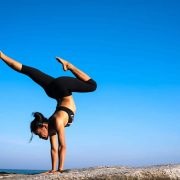Avoid Injuries Through Strength Training
In this article, we will discuss the benefits of strength training for athletic performance and how to incorporate it into your weekly training regimen. There are numerous professional opinions on whether or not strength training should be an instrumental part of an athlete’s training program. Overall body strength will help prevent the effects of cumulative fatigue and allow for proper efficiency for swimming, cycling and running. Also, full body strength is a complement to the other elements of a complete performance training program: endurance, flexibility, nutrition and mental preparedness.
Let’s take a look at three direct benefits of strength training from a physiological stand point and how it relates to athletic performance. First, strength training will increase the amount of force your muscles can exert on a particular object. As an athlete, moving your body weight through multiple disciplines plus offsetting external resistance factors like wind and hills to the working muscle, force (the by product of strength training) is the key component for finishing a race as strong as you started. [Note: this is especially true for females.]
Second, strength training will permit your muscles to reach a maximum output of force in a shorter period of time. Weight training will increase and facilitate the balance of strength in all working muscles and the resulting motor units (which include motor nerves and muscle fibers). One nerve impulse can charge hundreds of fibers at once; a rapid series of multiple fiber twitches can generate maximum force quickly and for a long period of time. Weight training will “teach” your nervous system to recruit a wide variety of fibers. As one group of fibers fatigue, another group will be prepared to relieve the fatigued group. Without getting to complex, think about nerves as messengers from the brain which control every physical response. If motor nerves don’t “tell” the muscle fibers to twitch, your muscles won’t contract. The entire concept behind physical training is to teach your nervous system, with repeating particular muscular movements, to get the correct message to the working muscles. With a diversified strength program, you will initiate a message to include the number of fibers to be recruited, type of fibers used (fast twitch A or slow twitch B) and frequency of contractions. Remember, a diversified training program will recruit all of the fibers and the types of fibers needed for the required physical demands. This is the purpose behind sports specificity and related workouts – the more specific the more productive.
Finally, the duration of time your muscles can sustain the level of force before exhaustion is extended. The overload principle is based on the concept of subjecting the muscles to slightly more load levels than it has incurred in the past. With incremental load levels, the muscles will increase the fiber solicitation and corresponding recruitment. With proper rest, the muscles will grow stronger by developing new muscle tissue as an adaptation to the load levels. With increased muscle mass, the muscles are able to exert higher levels of force and for extended periods of time before exhaustion. To capture a better idea of this concept, imagine you have muscles that fall under the category of primary and secondary muscles. The primary muscle groups are the obvious muscles that are responsible for assisting movement. The secondary muscle groups are also referred to as “assisters” for primary movement. However, once the primary muscle groups fatigue, the secondary muscles are required to step up to finish the task at hand. Strength training makes this task familiar to the secondary muscle groups at both the muscular and neuromuscular levels.
Three indirect benefits of strength training include stronger tendons and ligaments, greater bone density and enhanced joint range of motion. Concerning tendons and ligaments, weight training will increase the size and overall strength of both which will increase the stability of the joints that they surround. Bone density will increase as a by product of tensile force being placed on the bones. Without this tensile force, the bones will actually become brittle and susceptible to breaking. An increased range of motion at the joint is due to the increased strength and size of the tendons and ligaments. This increased strength will enhance the ease of mobility within the joint due to tendon and ligament strength and resulting efficiency. When you look at all three of these components collectively, they address the concern of every athlete – muscular strength, endurance and flexibility. Keep in mind that the ultimate goal of the muscles and a self protecting mechanism called the Golgi Apparatus are to keep the bones from being taken outside the normal range of motion. If your have a strong muscular system (accompanied with good flexibility), you have established a foundation for optimum fitness because your body has the proper mechanisms to protect itself.
Now that we have justified the reason for incorporating strength training into your performance program, let’s take a look at how to incorporate strength training into your weekly training regimen.
The first variable to look at is where you are at in your race season. If it is early in the season, your focus is to prepare your body for the upcoming demands of your pre-competitive season (low priority racing). During this time frame, you are also looking to enhance your aerobic function to keep the stress from becoming too stressful, the amount of weight is kept to a moderate level and three workout sessions a week. During the competitive racing season, the strength component of your program needs to be reduced to two sessions during the week to allow for ample rest for high intensity training and competition. For this article, we will assume that you are well into your competitive cycle and looking to peak at one or two key events during the summer.
It is important to take the time and evaluate the weaknesses of your current fitness through regular field testing. As athletes, we tend to work on the elements that we like to do and usually are very good at. However, to complete yourself as an athlete, you have to identify your weaknesses and address these variables specifically. With our athletes, we have pre-determined field testing dates to evaluate if the training programs we are implementing on a weekly basis are addressing the identified weaknesses of the athlete. So if your field testing results show that you are not lacking in the strength department, your approach in the gym will be different to an athlete who lacks overall physical strength.
STRENGTH ASSESSMENT
The subject of strength assessment has had a lot of varying opinions on what is the correct format to assess strength as it relates to racing. We incorporate two elements into the assessment equation: sport specific and gym specific load levels. Please keep in mind that the implementations of testing protocols are established based on the individual athlete and his or her backgrounds, along with age and racing capabilities. The following outline is merely an example of what can be used for assessment purposes within the gym.
Gym Testing Assessment
Take each of your gym exercises and take the average weight amount that you have been using over the last two weeks. Complete as many repetitions that you can complete with good form (no swinging – no momentum) until you can not complete any more repetitions. Using a load level calculator (there are many of these calculators on the internet), you can determine what your max strength level is for each muscle group. The idea behind this test is to determine what load levels and repetitions you should be using during your time in the gym. Remember, our goal with strength training is to optimize your time in the gym to enhance your overall body strength as it relates to swimming, cycling and running.
Together with your sport specific assessments and gym assessment numbers, you have the foundation to create your own individualized strength program. If you have questions about your testing results, please feel free to email the testing data to us at Contact@CoachRobb.com and we will provide you with some training protocols to enhance your strength program.
How Do I Determine What Muscles Are Weak?
To keep things in perspective, we are analyzing the athlete’s body in three planes: front and back top and bottom left and right side. The more in balance we can keep the strength levels in the related muscle groups found within each of these two planes, the higher the overall strength levels. For example, we would like to see similar strength levels in the quadriceps (front of leg) and the hamstrings (back of leg) to avoid unnecessary strains around the knee. We would like to have the chest muscles as strong as the back muscles to avoid any strains to the shoulder capsule. Though there are typically some strength discrepancies amongst muscle groups (front and back of the body for example), we are constantly striving to develop functional integration of all muscle groups to avoid unnecessary injuries.
What Muscle Groups Do I Need to Work On in the Gym?
The answer to this question is all muscle groups! If you can identify one muscle that is not used during a race, then you have found a muscle that you don’t have to train during your strength workouts. From head to toe, we are looking to enhance your overall body strength. As a rule of thumb, the muscle groups that you identify as weak based on your load level calculations, need to be put under more load levels and lower repetitions than the established strong muscles (which would need moderate load levels and higher repetitions). Remember, once we get your weaknesses to match your strengths, then your overall program has risen to the next level of capability and performance potential.
What Exercises Do I Need to Complete in the Gym?
There are three key weak links in an athlete’s overall strength program: 1. Lack of core body strength 2. Lack of balance between prime movers and antagonist muscle (i.e. biceps and triceps in the arms and the quadriceps and hamstrings in the legs) 3. Lack of flexibility in all muscle groups
While in the gym, we prefer to use stretch cords and individual dumbbells for all strength work for one main reason – the solicitation and development of the stabilizer muscles around each joint versus the machine doing this work for you. Please consult a qualified personal trainer at your gym to help you determine which exercises you will be doing to develop strength and show you the proper form with all of your lifting exercises. Keep in mind that it is better to have quality lifting exercises than to have quantity. Also, don’t be afraid to change up the program every four weeks to avoid getting bored and allow the muscles to get stale with your program.



